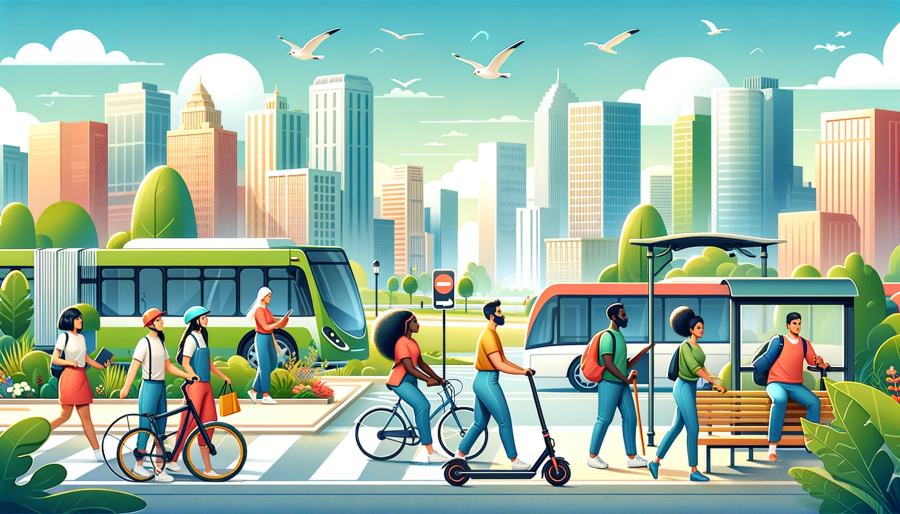
Dive into the world of eco-friendly transportation with our engaging guide. Discover sustainable travel methods that benefit both you and the planet!
Eco-Friendly Transportation Key Takeaways:
- Eco-friendly transportation refers to travel methods that minimize environmental impact.
- It includes cycling, walking, public transit, and electric vehicles.
- The aim is to reduce emissions and promote sustainability.
Intro Paragraph: Welcome to the exciting world of eco-friendly transportation!
It’s not just about getting from A to B; it’s about making a positive impact on our environment while enjoying the journey.
Let’s explore how simple changes in our travel habits can lead to a greener, healthier world.
Eco-friendly transportation refers to travel methods that minimize environmental impact.
It includes cycling, walking, public transit, and electric vehicles, aiming to reduce emissions and promote sustainability.
Eco-Friendly Transportation: Steering Towards a Greener Tomorrow
We’re at a pivotal juncture in our environmental journey, where every step towards sustainability counts.
One critical leap we can make is in the realm of transportation. It’s about rethinking our travel, not just for the sake of our planet, but for our well-being and wallets too.
Key Takeaways
- Embracing Sustainable Transportation: Understanding its importance for our environment and society.
- Diverse Modes: Exploring various eco-friendly transportation methods.
- Infrastructure and Policies: The role of supportive structures and initiatives.
Introduction to Sustainable Transportation
In our quest for a greener future, minimizing global oil consumption stands paramount.
This quest calls for innovative transportation methods that harmonize with ecological principles.
Sustainable transportation isn’t just a boon for our environment; it enhances our health, eases our finances, and enriches our life quality.
What is Sustainable Transportation?
Sustainable transportation transcends conventional travel methods, prioritizing reduced emissions, energy conservation, and efficient resource utilization.
This encompasses public transport like buses and subways, simple practices such as biking and walking, and shared commutes via carpooling or ridesharing.
Each mode brings unique benefits and inches us closer to an environmentally conscious lifestyle.
Electric vehicles and clean fuel alternatives are revolutionizing travel, cutting down our dependence on non-renewable energy.
As we pivot from oil-centric models to these sustainable options, we’re crafting a future where eco-friendly choices steer our transport narratives.
Examples of Sustainable Transportation and Their Benefits
Public Transit
Mass transit systems like buses, trains, and subways play a vital role in urban mobility and sustainable city development.
They’re surprisingly efficient in reducing emissions compared to individual cars, thanks to their capacity to transport many passengers at once.
These systems not only foster environmental well-being but also promote social equity and are pivotal in smart city planning.
Cycling and Walking
Embracing cycling and walking for daily commutes offers profound health benefits while contributing significantly to environmental conservation.
These activities boost physical fitness and mental well-being, making them perfect examples of sustainable transportation.
Micromobility
Innovations like e-bikes, e-scooters, and electric skateboards are reshaping urban transport.
These compact, eco-friendly options are ideal for short distances, reducing traffic congestion and emissions.
Micromobility demonstrates a forward-thinking approach to city mobility, emphasizing environmental care and transport efficiency.
Building Eco-Friendly Transport Infrastructure
The backbone of any successful sustainable transportation system is robust infrastructure.
It’s not just about providing alternatives but also about ensuring accessibility and safety. Innovations in road design, dedicated bike lanes, and well-planned public transport networks are crucial.
Such infrastructure encourages people to opt for greener modes of transport, effectively reducing the overall environmental impact.
Policies and Initiatives for More Sustainable Transportation
Government and private sector initiatives play a pivotal role in fostering eco-friendly transport.
Subsidies for electric vehicles, investments in public transit infrastructure, and policies encouraging reduced car use are some examples.
These efforts not only facilitate the shift towards greener transport options but also demonstrate a commitment to a sustainable future.
Measuring the Impact of Eco-Conscious Travel
Assessing the effectiveness of sustainable transport involves looking at emission reductions, energy savings, and societal benefits.
Case studies from around the world provide valuable insights into the positive impact of eco-friendly transport practices, from reduced air pollution to enhanced urban livability.
The Role of Technology in Green Transportation
The intersection of green technology and green transportation is creating exciting possibilities.
From electric vehicles with advanced battery technologies to smart traffic management systems, technology is at the forefront of this green revolution.
Innovations are not only making sustainable transport more accessible but also more efficient and appealing to the masses.
Challenges and Issues in Sustainable Transportation
While the shift towards eco-friendly transport is gaining momentum, it’s not without its hurdles.
Issues like funding, public acceptance, and infrastructure adaptation pose significant challenges.
Addressing these requires a collaborative approach, involving policymakers, industry players, and the public.
Innovative solutions and persistent efforts are key to overcoming these barriers and paving the way for a more sustainable transport future.
Incorporating real-world examples of successful sustainable transportation projects into the article can provide practical insights and highlight effective strategies. Here are some examples, complete with references:
- Nottingham, UK – Improving Bus Services: Nottingham City Council utilized its powers over bus stops, timetables, and routes to improve bus quality and services, enhancing public transportation efficiency and accessibility. Nottingham | Centre for Cities
- Helsinki, Finland – Integrated Transport Planning: Helsinki Region Transport successfully integrated the planning of bus services with other modes of transport in the region, creating a more cohesive and user-friendly public transport system.
- London, UK – Direct Regulation of Bus Services: Transport for London gained the authority to directly regulate bus services, significantly improving the quality and efficiency of public transport in the city. London | Centre for Cities
- Paris, France – Long-Term Funding for Infrastructure: The French Government’s commitment to providing long-term funding certainty for transport infrastructure encouraged investment and development in sustainable transport options.
- Dublin, Ireland – Data-Driven Public Transport Improvement: Dublin City Council, in collaboration with IBM, used data sharing to improve the public transport network, demonstrating the importance of technology in enhancing transport services.
- Copenhagen, Denmark – Investment in Cycling Infrastructure: The Copenhagen City Council’s focus on investing in cycling infrastructure has made the city a global model for sustainable urban mobility, emphasizing the benefits of non-motorized transport.
- Montpellier, France – Introducing a Tram System: In response to fast population growth, Montpellier Agglomeration introduced a tram system, improving connectivity and reducing the reliance on private vehicles.
- Eugene, Oregon, USA – New Bus System: Eugene’s Lane Transit District and City Council introduced a new bus system to provide better links between the city center and surrounding areas, showcasing how mid-sized cities can enhance public transport.
- New York City, USA – Reducing Vehicle Idling: Efforts by the New York City authority to reduce vehicle idling have contributed to cleaner air and a healthier urban environment.
- Los Angeles, USA – Demand-Based Parking System: Los Angeles introduced a demand-based parking system to reduce congestion, highlighting innovative approaches to traffic management.
These examples illustrate various approaches cities around the world have taken to enhance eco-friendly transportation, from improving public transport services to investing in cycling infrastructure and utilizing technology for better transport management.
Incorporating these case studies can provide valuable insights and inspiration for other cities and regions aiming to improve their sustainable transportation systems.
Transport is at the center of many economic and social development challenges, accounting for about 64% of global oil consumption, 27% of all energy use, and 23% of the world’s energy-related carbon dioxide emissions. Rethinking and revamping transit in the post-COVID era by implementing structural changes would go a long way toward reinforcing some of the positive impacts on emission levels and air quality created by efforts to curb the pandemic.
https://www.iisd.org/articles/deep-dive/road-sustainable-transport
The Future of Sustainable Transportation
Envisioning the future of sustainable transportation involves a blend of innovative technologies, policy reforms, and a shift in public mindset.
We’re likely to see an increase in electric and autonomous vehicles, more efficient public transport systems, and cities designed with sustainability at their core.
This future hinges not just on technological advancements but also on societal willingness to embrace greener transportation options.
6 Practical Tips for Adopting Greener Travel Methods
- Opt for Public Transport: Whenever possible, choose buses, trains, or trams over personal vehicles.
- Embrace Cycling and Walking: For shorter distances, cycling or walking can be both healthy and eco-friendly.
- Carpooling: Share rides with friends or colleagues to reduce the number of vehicles on the road.
- Use Electric Vehicles: Consider switching to electric cars or bikes for cleaner transportation.
- Plan Efficient Routes: Optimize your travel routes to reduce unnecessary travel and save fuel.
- Support Green Transportation Initiatives: Advocate for and support local policies and projects that promote sustainable transportation.
FAQs Section
Navigating the world of sustainable transportation can bring up many questions.
Whether you’re a daily commuter, a city planner, or simply someone looking to reduce your carbon footprint, understanding eco-friendly transportation is key.
Here, we address some of the most commonly asked questions to clarify concepts and encourage informed choices toward greener travel.
Q1: What is eco-friendly transportation?
A1: Eco-friendly transportation refers to modes of transport that have a reduced environmental impact, such as bicycles, electric vehicles, and public transit.
Q2: Why is sustainable transportation important?
A2: Sustainable transportation is crucial for reducing carbon emissions, combating climate change, and creating healthier urban environments.
Q3: Can switching to eco-friendly transportation methods significantly impact the environment?
A3: Yes, adopting greener travel methods can significantly reduce carbon emissions and pollution, contributing to a healthier planet.
Conclusion: Embracing the Journey Towards Sustainable Transportation
As we conclude, it’s clear that eco-friendly transportation is not just a trend but a necessary shift towards a sustainable future.
- Collective Responsibility: It’s up to each of us, individuals and communities alike, to make conscious transport choices.
- Technological Advancements: Continued innovation in green technology is essential for progress in this area.
- Policy and Community Support: Governmental policies and community initiatives play a crucial role in facilitating this transition.
- Health and Environmental Benefits: Adopting eco-friendly transportation methods significantly contributes to personal health and environmental conservation.
- Future Outlook: The journey towards sustainable transportation is ongoing, with new developments and challenges ahead.
Together, we can drive towards a future where transportation is not only efficient but also harmonious with our environment.
Let’s make the switch to more sustainable transport methods and save our planet.






